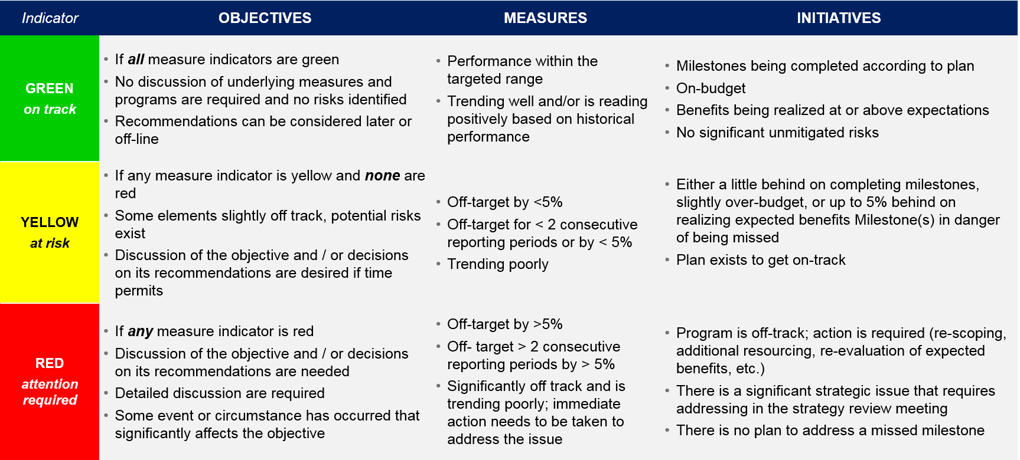Status colors are a critical component of the Balanced Scorecard. They instantly illustrate performance to any audience, and signify key areas of discussion to planners and leadership teams.
Most organizations follow a straightforward red, yellow, green stoplight approach for status colors. A red status color indicates below-target performance or underlying critical risks. Yellow indicates a narrowly missed target, or poorly trending performance that may impact end-of-year targets. And of course green implies on-target performance.
The stoplight approach’s greatest strength is its intuitive logic. Despite that simplicity, many organizations run into trouble when faced with Balanced Scorecard owners that refuse to mark items as red, even if performance is lagging. Tackling the fear of “red is dead” is a common part of every Balanced Scorecard implementation.
One common solution is to create standard business rules for setting the status colors for objectives, measures, and initiatives. This process-based solution is effective because it works to shift the performance management culture away from "my job-on-the-line" fearful accountability, to one where owners are empowered to ask other leadership for assistance with significant challenges.
In the example below, objectives, measures, and initiatives each have their own business rules for status colors.

Status colors for initiatives are focused on the performance of the initiative against its planned implementation. Initiative management and scoring tend to follow a project management approach.
Measures differ from initiatives by focusing on a strict relationship between actual and target performance. Some organizations choose to look at this solely on a year-to-date basis, while others zero in on the current quarter of performance. Measure status colors are the least subjective, and are the easiest to automate.
Objectives should summarize the performance of all related measures. I suggest to avoid mixing initiatives into the equation for objective status color setting. Including initiatives can muddle the cause-and-effect logic in the BSC by confusing inputs, outputs, and the final goal of an objective/measurement.
Technology can also be useful for determining status colors. Balanced Scorecard software can automatically set status colors based on business rules that strategic planners determine. For example, our own tool, ESM+Strategy can automatically set objective colors based on related measures, set measure status based on actual-target performance, and initiatives based on the progress-against-plan.
Whether using software or a manual BSC process to determine status colors, it is critical to have a consistent approach. If a Balanced Scorecard is all green or yellow, then it is likely that either targets are too low or there is a cultural fear of accountability.







